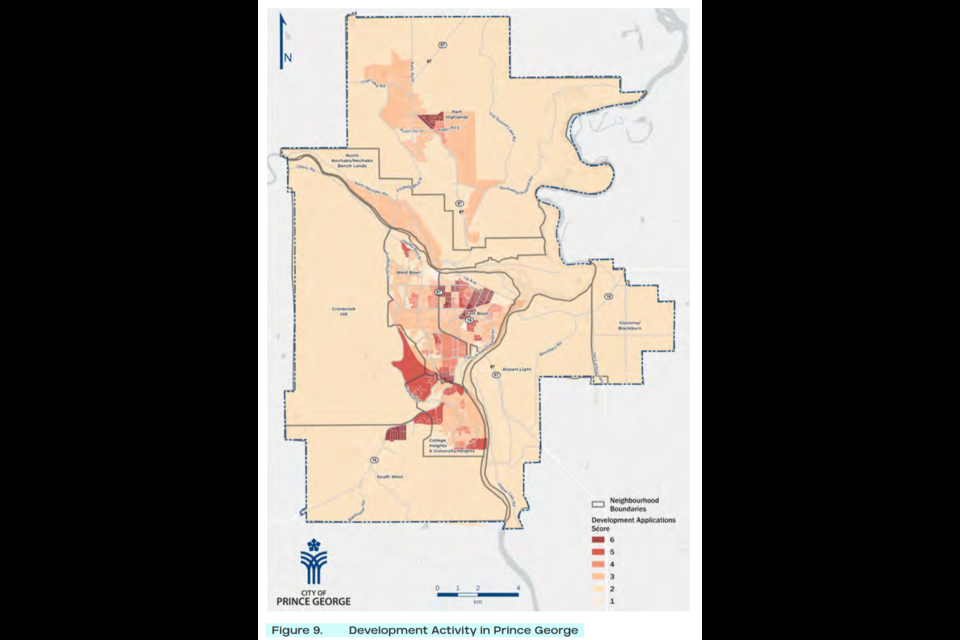Prince George faces development and infrastructure challenges as it looks to grow, according to a new community assessment more than a year being presented to city council at its Monday, Jan. 13 meeting.
In mid-2023, city administration hired a consultant to help prepare a Complete Community Assessment using $150,000 in grant money from the Union of BC Municipalities.
The CCA is intended to complement the revision of Prince George’s Official Community Plan and serve as a guide for how to use existing infrastructure and maintain services as the city grows.
The 159-page report was finished in December 2024 and will be discussed by council at its first meeting of 2025.
The executive summary at the beginning of the report says that it was assembled through “extensive spatial analysis of community data obtained from a range of sources, including municipal and provincial datasets.”
Also included was engagement with community members, local developers and city staff as well as financial analyses.
The report says that current conditions mean that many types of development are not economically feasible, though housing looking to fulfill certain social and affordability goals for housing are more likely to succeed because there are external funding sources.
As also stated by a recent interim housing needs report, the CCA says that multiple types of housing are needed in Prince George, especially higher-density, multi-family and affordable ones.
Roadblocks to new developments in Prince George were identified as a lengthy approval process, limited information on the capacity levels of infrastructure, high construction costs and a labour shortage.
Also on the infrastructure point, the CCA says “much of the city’s sanitary, storm and water sewer system infrastructure is vulnerable and due for upgrades.”
A table assessing infrastructure readiness shows that College Heights and University Heights need the most work, with no additional capacity for the sanitary sewers, issues with storm drains should development continue and potential issues with water flow for firefighting.
However, the East Bowl and downtown were said to have the biggest issues with fire flow, with small water mains and less than 60 litres per second of water available.
To address these issues, the CCA makes four high-level recommendations:
- Direct the construction of new housing to areas that have “daily needs amenities,” connections to the transportation network and infrastructure capacity,
- Streamlining the development approvals process to attract investment,
- Monitor and document regularly the servicing capacity of infrastructure and document that information and
- Accommodate new growth and development by co-ordinating capital investments in critical infrastructure.
A breakdown of the city’s demographics in the CCA says that between 2011 and 2021, the seven per cent population growth rate Prince George had was half that of the province’s overall 14 per cent growth rate.
On top of that, Prince George is said to have a greater proportion of residents under 20 years old and aged 20 to 24 compared to the rest of the province.
The city’s average household size is 2.4 people per unit, which matches the provincial average. However, Prince George has more single-detached and moveable dwellings and fewer two-unit and apartment buildings than the provincial average.
Prince George is also said to have lower average monthly housing costs and a higher unemployment rate than the provincial average.
The provincial average for housing costs for homeowners is $1,668 and $1,494 for renters, compared to $1,330 for homeowners and $1,084 for renters. The province’s overall unemployment rate is 8.4 per cent, a full percentage point higher than Prince George’s 9.4 per cent rate.
A map of housing density in the city contained within the report shows that the bowl is the most densely populated part of the city, especially in the East Bowl centred around downtown. The next densest parts of the city are College Heights and University Heights.
Another map shows the proportion of home renters to homeowners. Again, the bowl sees the highest proportion of renters, especially downtown and in the West Bowl.
There’s also a map ranking how much development has gone on in different parts of the city between 2012 and 2024.
“Since 2012, most of Prince George’s development activity has been concentrated in the Hart Highlands, College Heights and University Heights, East Bowl (downtown) and West Bowl,” the report says.
Other maps in the CCA show various neighbourhoods’ proximities to city parks, community facilities, commercial facilities, cycling infrastructure, sidewalks transit and the density of roads and trails.
The full report can be viewed online at pub-princegeorge.escribemeetings.com/filestream.ashx?DocumentId=29724
The meeting will start at 6 p.m. Monday inside council chambers on the second floor of Prince George City Hall. For those who cannot attend in person, the meeting will be livestreamed at princegeorge.ca.

.png;w=120;h=80;mode=crop)

